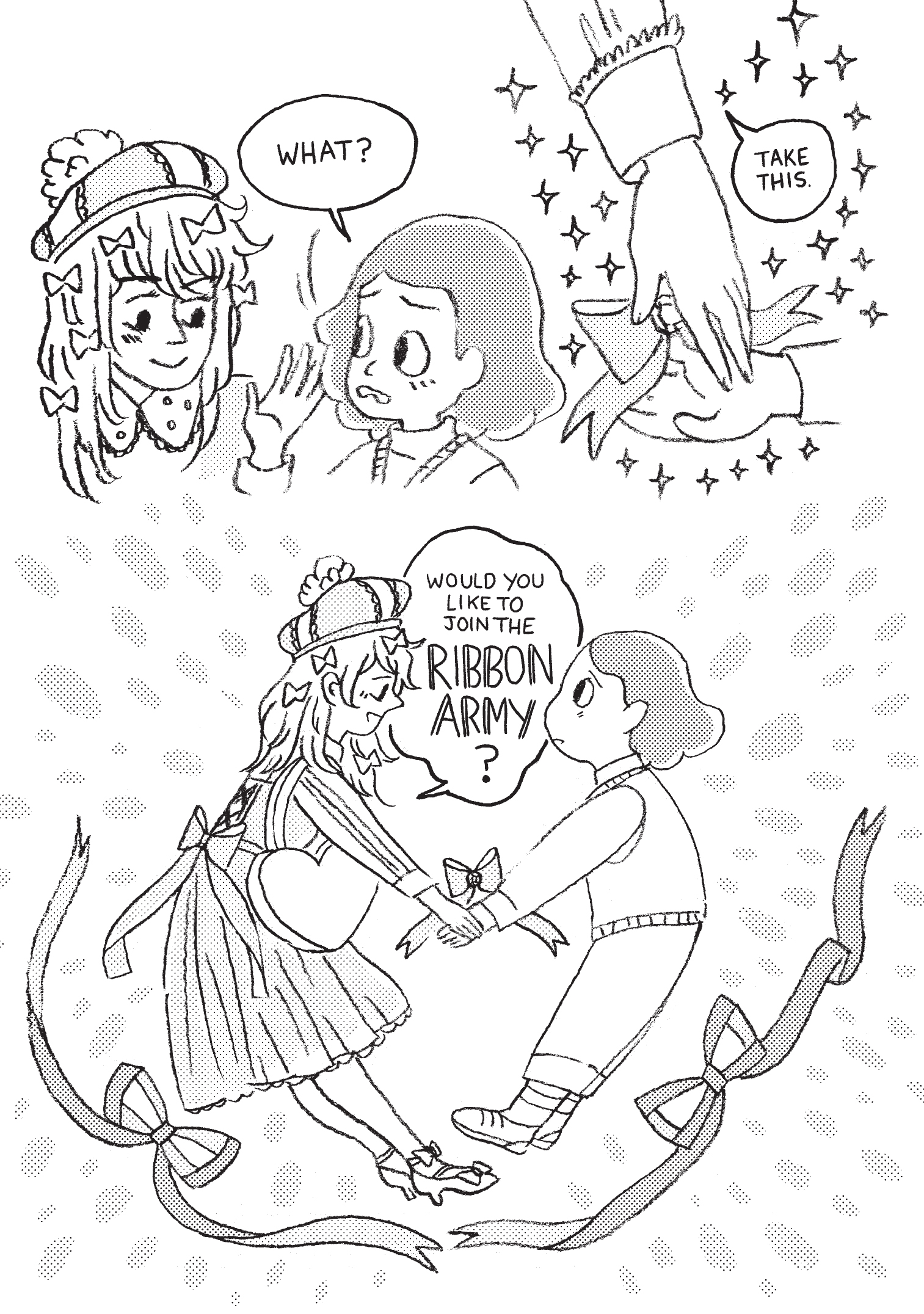The word “lolita” is a loaded gun. Though Vladimir Nabokov’s titular novel casts its protagonist, Humbert Humbert, in ill light, it’s Lolita née Dolores who bears the story’s most lasting moral impression—that of the coquette and the girl who grew up so fast that her enticing beauty becomes an unavoidable trap, which is reinforced by Stanley Kubrick’s film adaptation.
Across the Pacific Ocean, “lolita” has come to mean something vastly different. Born out of Japanese street style culture in the 70s, Lolita fashion is intricate, layered, and visually modest; a version of femmehood that doesn’t hinge on sexual maturity, or traditional notions of (straight male-centric) sexuality. Lolita fashion reached its most popular heights back in the early to mid-2000s through the crossover medium of “visual kei” bands, which brought with them a melange of gothic, aristocratic, and heavy metal aesthetic influences—Gothic Lolita style, which has a more macabre focus than traditional Lolita looks.
Videos by VICE
Why does this Lolita share a name with one of Western pop culture’s most hypersexualized characters? This is a question that even Lolita‘s most enthused historians can’t answer, but in So Pretty/Very Rotten, out today on Koyama Press, artists and writers Jane Mai and An Nguyen tackle the subculture’s history, iterations, and nuances. The result is a love letter to the movement, as a subtle critique of its generally materialistic nature, and an exploration of their own nascent identities—all built on wondrous, anachronistic clothes.

So Pretty/Very Rotten takes its name from the 2004 Japanese film Kamikaze Girls, which was adapted from a Novala Takemoto novel. The film’s two protagonists embody different kinds of Japanese youth street culture: the “Yanki” delinquent Ichigo and the Sweet Lolita Momoko. Though Momoko looks like a living doll, the clothes mask her less pristine reality, and she steals and lies to make her living and afford the extravagant clothes. Momoko proclaims, “So what if I was deceitful? My happiness was at stake. It’s not wrong to feel good. That’s what Rococo taught me. But actually my soul is rotten.”
This conflict—between pervasive and almost unavoidable materialism and the personal satisfaction that can be gleaned from material goods—is ongoing. (See: social lifting culture.) Mai and Nguyen, who started working on this idea in 2014, dress in Lolita styles themselves. They trace their admiration of the style to other shared subcultural interests but still, at the center, the clothes. Though they both agree on Lolita’s complicated, inherent materialism, Mai and Nguyen also take pains to examine the magnetic promise they fulfill by wearing Lolita; a pull that perhaps all young people feel, and of which Lolita is just one form.
“I make things that are appealing or understanding toward teenage girls, because it’s a difficult time in anyone’s life,” Mai shares over a phone conversation. She encountered the Lolita world as a teen through visual kei musicians, whose fluid androgyny offered a bridge between her earlier tomboy years and the more ultra-feminine Lolita styles. (Lolita fashion, though heavily femme-centric, also includes “prince”/”boystyle” looks, known as ouji style.) Nguyen, who’s researched the topic heavily and does most of the essay-writing in the book, came to Lolita through a different avenue—a focus on literature, 70s Japanese manga, and underground music. “Our book isn’t just about the creative production of Lolita,” Nguyen offers, “It’s about the human feeling.”
Fictional explorations of Lolita fashion and culture in the form of comics make up much of the book. Nguyen and Mai have contrasting styles, and the visual dichotomy can be startling. This is perhaps the only book where you’ll read a body horror story about a girl trading her body for clothes (“Empty,” by Mai) alongside an earnest and pure take on the “secret admirer” trope (“Ribbon Army,” by Nguyen).
The rest of the book is populated by personal essays, anthropological explorations of the Lolita subculture (courtesy of Nguyen’s years of research), and two chapters—an essay and an interview by Nguyen—devoted to Novala Takemoto. The researched aspects are particularly delightful, presenting topics like the disconnect between more individual Lolita observers in Japan and more communal ones outside its origin country. But the personal narratives, supplied by Mai and Takemoto, offer up more complete morphologies of their Lolita relationships.
Both Mai and Nguyen know they’re too close to the subject to offer up a truly objective take on Lolita culture, and its more ambiguous qualities don’t escape either of them. To Mai, the joy of Lolita’s clothes doesn’t mask its inherently materialistic nature: “It is such an excessive hobby to have.” To Nguyen, Lolita’s sometimes extreme aesthetic is in dialogue with inevitable mortality: “These are adults, not little girls or children. This is a suspension of time; your way of ignoring it for a while.”
Those are more individual-centered conflicts, but Lolita’s origins as a Japanese subculture also bring up strange assumptions about race and nation. Mai often fields questions about her “true” identity: “The most common question I get is, ‘Where are you from?’ I know that they’re expecting me to say, ‘Oh, I’m from this country, I’m from Harajuku,’ and they get mega-disappointed when I say I’m from Brooklyn.”
“It’s not really [an asker’s] fault, but it’s something that annoys me because, I know some other girls that wear lolita, and they’re white. They get asked if they’re in a play, as opposed to where are you from.”

Nguyen shares a tale of pan-East Asian assimilation—or rather, not: “When I was growing up, I had friends that were Chinese, and they were really interested in Japanese anime and visual kei and stuff. A lot of them talked about their parents or their grandparents didn’t like it—that they were so into Japanese stuff, because of all the cultural baggage between the two countries.” This same dilemma didn’t exist for white kids, she claims, whose families have a broader understanding of teen subcultures: “For other families, it’s just a teen thing that they can do, it’s part of growing up. Whereas [in our families]… ‘Oh, you’re not a good kid’.”
It doesn’t help that Lolita fashion is still quite an unknown subculture in the West—with the hilariously dated exception of American singer Gwen Stefani’s Harajuku Girls phase. Mai and Nguyen are blithe about their distaste for this “version” of Lolita, but it remains perhaps the culture’s most popular image, which Mai sees as a double-edged sword: “On one hand, it could totally paint someone’s idea of what Lolita is… But on the other hand, if you’re actually gonna try to explain it, it’s a reference point for them. It’s their closest access.”
Lolita still maintains a global presence, but it’s focused more on surface visuals and loses some of the original tethers that drew in earlier adopters like Mai and Nguyen. Neither is bitter about this development, and Nguyen ascribes Lolita’s longevity to its growth beyond Japanese culture: “It’s been quite resilient as a fashion subculture. The growth that you do see is mostly outside of Japan.”

So Pretty/Very Rotten comes out in an uncertain time for Lolita adherents. FRUiTS, the longtime Harajuku street style bible, is no more; during the course of writing their book, Mai learned that the equally iconic style tome Graphic Lolita Bible is also folding. Those were the resources for an entire generation of Lolitas, and in their absence, there’s a real fear that the aesthetic can become just another thing to be mined by global fast fashion’s deft, appropriative hand, or else totally divorced from its indie beginnings.
Though many, including Takemoto, are working on a definitive history of the subculture, there exist few resources of this kind, let alone regularly accessible or non-Japanese ones. For Mai, “It’s important, at least to me, that someone at least has written it down. Even if this subculture is waning, it’s made a real thing that exists in history, and I was able to be part of it. I hope other people can feel that way as well, valid.”
Nguyen echoes this statement: “No matter what generation you’re in, there’s always gonna be something like it. Lolita is its own special thing; nothing will ever be exactly like it. But people are always gonna try to find something that we tried to find … To share that with other people. To create a snapshot of something that meant a lot to us that one time, and also, now.”
Follow Lilian Min on Twitter.
More
From VICE
-

Photo: Svetlana Iakusheva / Getty Images -

Photo: Marc_Osborne / Getty Images -

Photo: Gremlin / Getty Images -

Photo: Antoine Rouleau / Getty Images
